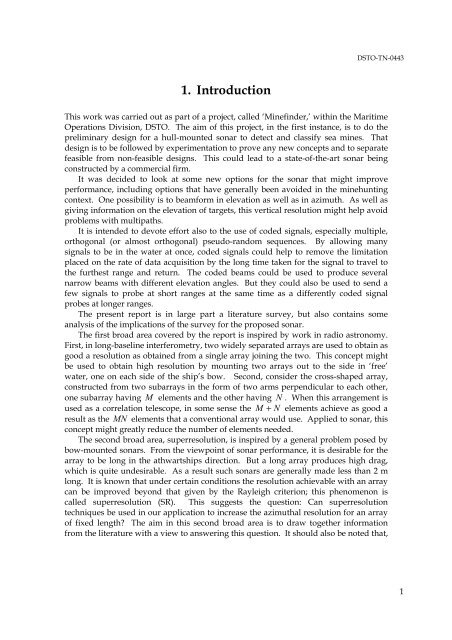Suitability of Correlation Arrays and Superresolution for Minehunting ...
Suitability of Correlation Arrays and Superresolution for Minehunting ...
Suitability of Correlation Arrays and Superresolution for Minehunting ...
You also want an ePaper? Increase the reach of your titles
YUMPU automatically turns print PDFs into web optimized ePapers that Google loves.
DSTO-TN-0443<br />
1. Introduction<br />
This work was carried out as part <strong>of</strong> a project, called ‘Minefinder,’ within the Maritime<br />
Operations Division, DSTO. The aim <strong>of</strong> this project, in the first instance, is to do the<br />
preliminary design <strong>for</strong> a hull-mounted sonar to detect <strong>and</strong> classify sea mines. That<br />
design is to be followed by experimentation to prove any new concepts <strong>and</strong> to separate<br />
feasible from non-feasible designs. This could lead to a state-<strong>of</strong>-the-art sonar being<br />
constructed by a commercial firm.<br />
It was decided to look at some new options <strong>for</strong> the sonar that might improve<br />
per<strong>for</strong>mance, including options that have generally been avoided in the minehunting<br />
context. One possibility is to beam<strong>for</strong>m in elevation as well as in azimuth. As well as<br />
giving in<strong>for</strong>mation on the elevation <strong>of</strong> targets, this vertical resolution might help avoid<br />
problems with multipaths.<br />
It is intended to devote ef<strong>for</strong>t also to the use <strong>of</strong> coded signals, especially multiple,<br />
orthogonal (or almost orthogonal) pseudo-r<strong>and</strong>om sequences. By allowing many<br />
signals to be in the water at once, coded signals could help to remove the limitation<br />
placed on the rate <strong>of</strong> data acquisition by the long time taken <strong>for</strong> the signal to travel to<br />
the furthest range <strong>and</strong> return. The coded beams could be used to produce several<br />
narrow beams with different elevation angles. But they could also be used to send a<br />
few signals to probe at short ranges at the same time as a differently coded signal<br />
probes at longer ranges.<br />
The present report is in large part a literature survey, but also contains some<br />
analysis <strong>of</strong> the implications <strong>of</strong> the survey <strong>for</strong> the proposed sonar.<br />
The first broad area covered by the report is inspired by work in radio astronomy.<br />
First, in long-baseline interferometry, two widely separated arrays are used to obtain as<br />
good a resolution as obtained from a single array joining the two. This concept might<br />
be used to obtain high resolution by mounting two arrays out to the side in ‘free’<br />
water, one on each side <strong>of</strong> the ship’s bow. Second, consider the cross-shaped array,<br />
constructed from two subarrays in the <strong>for</strong>m <strong>of</strong> two arms perpendicular to each other,<br />
one subarray having M elements <strong>and</strong> the other having N . When this arrangement is<br />
used as a correlation telescope, in some sense the M + N elements achieve as good a<br />
result as the MN elements that a conventional array would use. Applied to sonar, this<br />
concept might greatly reduce the number <strong>of</strong> elements needed.<br />
The second broad area, superresolution, is inspired by a general problem posed by<br />
bow-mounted sonars. From the viewpoint <strong>of</strong> sonar per<strong>for</strong>mance, it is desirable <strong>for</strong> the<br />
array to be long in the athwartships direction. But a long array produces high drag,<br />
which is quite undesirable. As a result such sonars are generally made less than 2 m<br />
long. It is known that under certain conditions the resolution achievable with an array<br />
can be improved beyond that given by the Rayleigh criterion; this phenomenon is<br />
called superresolution (SR). This suggests the question: Can superresolution<br />
techniques be used in our application to increase the azimuthal resolution <strong>for</strong> an array<br />
<strong>of</strong> fixed length? The aim in this second broad area is to draw together in<strong>for</strong>mation<br />
from the literature with a view to answering this question. It should also be noted that,<br />
1

















